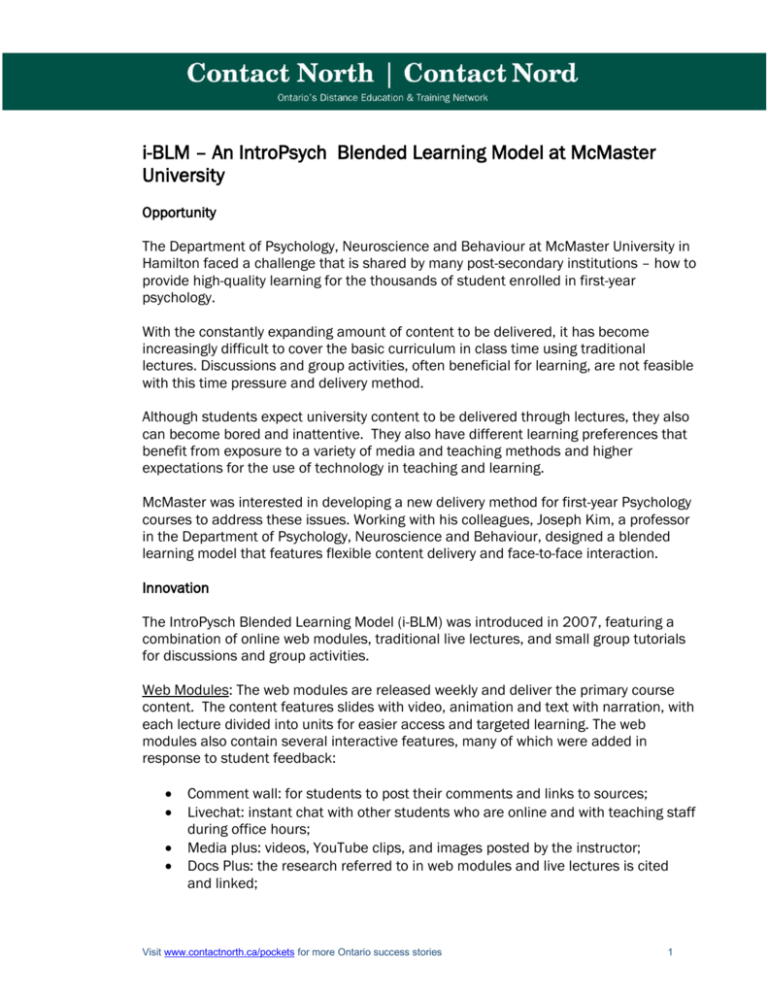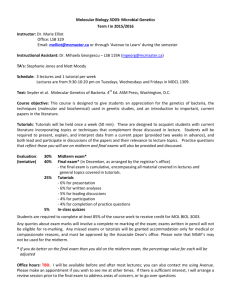i-BLM – An IntroPsych Blended Learning Model at McMaster
advertisement

i-BLM – An IntroPsych Blended Learning Model at McMaster University Opportunity The Department of Psychology, Neuroscience and Behaviour at McMaster University in Hamilton faced a challenge that is shared by many post-secondary institutions – how to provide high-quality learning for the thousands of student enrolled in first-year psychology. With the constantly expanding amount of content to be delivered, it has become increasingly difficult to cover the basic curriculum in class time using traditional lectures. Discussions and group activities, often beneficial for learning, are not feasible with this time pressure and delivery method. Although students expect university content to be delivered through lectures, they also can become bored and inattentive. They also have different learning preferences that benefit from exposure to a variety of media and teaching methods and higher expectations for the use of technology in teaching and learning. McMaster was interested in developing a new delivery method for first-year Psychology courses to address these issues. Working with his colleagues, Joseph Kim, a professor in the Department of Psychology, Neuroscience and Behaviour, designed a blended learning model that features flexible content delivery and face-to-face interaction. Innovation The IntroPysch Blended Learning Model (i-BLM) was introduced in 2007, featuring a combination of online web modules, traditional live lectures, and small group tutorials for discussions and group activities. Web Modules: The web modules are released weekly and deliver the primary course content. The content features slides with video, animation and text with narration, with each lecture divided into units for easier access and targeted learning. The web modules also contain several interactive features, many of which were added in response to student feedback: Comment wall: for students to post their comments and links to sources; Livechat: instant chat with other students who are online and with teaching staff during office hours; Media plus: videos, YouTube clips, and images posted by the instructor; Docs Plus: the research referred to in web modules and live lectures is cited and linked; Visit www.contactnorth.ca/pockets for more Ontario success stories 1 Polls: embedded polls that measure student opinion with immediate posting and updating of results; Checkpoints: short test questions with feedback at the end of each unit to allow students to assess their understanding; Testing: there are weekly online tests with multiple choice questions that assess conceptual understanding and application of the knowledge. There are 12 weekly tests and the top ten marks count for 40% of the students’ final grade; and Feedback: students provide comments on the content and delivery of the web lectures. Weekly Live Lectures: Professor Kim gives one weekly live lecture for each class during which he builds on the web lectures by providing case studies, anecdotes, research applications, and demonstrations of how the theory the students are learning is reflected in life. As the lectures no longer have to deliver the entire course content, they can be more dynamic and engaging while complementing and expanding the web modules. The weekly lectures are attended by about 90% of the students and offer an opportunity for direct interaction with the course instructor. Weekly Tutorials: The weekly tutorials are delivered by teaching assistants (TAs) for groups of 26 students. The tutorials provide for the direct interaction among the students and the TA, with discussions and group activities. The students are graded on their tutorial participation. Visit www.contactnorth.ca/pockets for more Ontario success stories 2 The TAs are all enrolled in an advanced psychology class taught by Professor Kim. As part of this class, the TAs prepare for the IntroPsych tutorials by having one team of TAs model how the upcoming tutorial could be organized and taught. The TAs then discuss this approach and determine how each tutorial is to be offered. Flexibility to respond to the specific needs of each tutorial group is built in, but this approach also provides consistency and clarity on the content and structure of each tutorial. Outcomes and Benefits Students were asked about their satisfaction with the web lectures as part of the endof-term evaluation. The April 2009 results showed that the great majority of students found the web modules to be effective learning tools. The most often cited reasons were the organization into modules for easy viewing, the interactive features, the ability to use them for review at their own pace and for note taking. The tutorials were also assessed, with more than 75% of students agreeing that the tutorials were beneficial. The students appreciated the activities and discussions, rather than a lecture or review, and reported that the TAs really cared. With the web lectures, the information is available to the students all the time. They can review the material at their choice of time and pace, revisiting the parts they need to concentrate on, moving from the lecture to the text and other support materials – in effect, structuring their learning as best suits their needs. This approach is of particular benefit to English-as-a-second-language and differently abled students. Of the thousands of student comments received concerning the course, the great majority are positive and, as a reflection of the variety of student learning styles and needs, relate to each and every aspect of the course structure and content. Challenges and Enhancements The student response was not positive in the first year as the web modules were found to be overly complex as they were initially designed to replace the need for a textbook. The modules were re-designed to function as guides to the essential knowledge, while the textbook provides the detail. In a research study, the impact of visuals was assessed – with the same narration accompanying slides with detailed bullet points, minimal text, or a blank screen. It was found that slides with minimal text, complemented by full screen, dynamic videos, led to the most effective learning and this design has been adapted. Self-paced learning can be a double-edged sword as the flexibility it allows also requires student responsibility to keep up with the materials. Some students needed Visit www.contactnorth.ca/pockets for more Ontario success stories 3 additional support and encouragement. Weekly tests that contribute substantively to the final grade were introduced to motivate more consistent studying. The creation of carefully designed web modules, not straight lecture podcasts, requires considerable time and resources. After four years of working with the i-BLM, Professor Kim has found that 30 minute modules seem to be ideal, offering distilled knowledge presented in a story structure. Context, not an encyclopaedic presentation of facts, is necessary for better learning. In the current design, each module begins with the introduction of a case study with a question at the end of each unit linked back to the problem presented in the case study. The tutorials also focus on problem-based learning. These cases have to be complex, realistic, with appropriate red herrings, and tied to the specific content. Potential McMaster University has entered into an agreement with Nelson Education Ltd. to develop a new Canadian Introductory Psychology textbook, teamed with the modules, which will be available for post-secondary educators in fall of 2012. Other institutions can develop a blended learning approach to the course based on the web modules developed at McMaster. Professor Kim is also the Director of the Pedagogy and Applied Cognition Lab at McMaster, where he and his team continue to investigate the optimal design of multimedia learning tools, leading to ongoing improvements to the i-BLM. For example, students often comment on the speed of the narration, but the comments range from ‘speaks too quickly’ to ’speaks much too slowly’. A seamless solution is being explored so that students could control the speed of the speech to their own pace of learning. Professor Kim is interested is discussions on how class time can be re-structured, building in technology and other instructional strategies for better teaching and learning. The i-BLM is just one aspect of this discussion that he would like to have with his colleagues at other post-secondary institutions. For Further Information Joseph Kim Assistant Professor Department of Psychology, Neuroscience and Behaviour McMaster University kimjoe@mcmaster.ca Sana, Faria, Barbara Fenesi, and Joseph A.Kim (2011). A Case Study of the Introductory Psychology Blended Learning Model at McMaster University. The Canadian Visit www.contactnorth.ca/pockets for more Ontario success stories 4 Journal for the Scholarship of Teaching and Learning, 2(1). Retrieved from: http://ir.lib.uwo.ca/cjsotl_rcacea/vol2/iss1/6 Dr. Kim’s talk about blended learning can be found at http://www.youtube.com/watch?v=q8vxpI5P4lM Visit www.contactnorth.ca/pockets for more Ontario success stories 5






